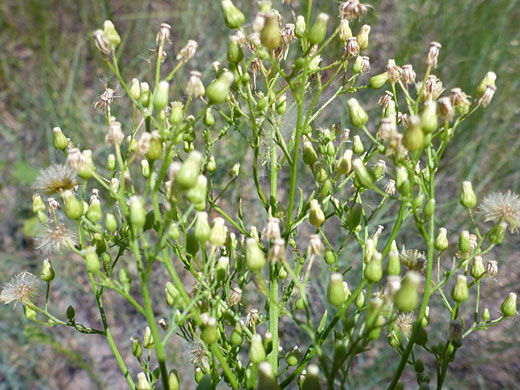
Green phyllaries and white florets of erigeron canadensis; Deerlodge Park, Dinosaur National Monument, Colorado
Common name:
Canadian horseweed
Family:
Scientific name:
Erigeron canadensis
Synonym:
Conyza canadensis
Main flower color:
Range:
All US states
Height:
Usually up to 7 feet
Habitat:
Riverbanks, roadsides, fields, other disturbed places, from sea level to 6,500 feet
Leaves:
Linear to narrowly oblanceolate, usually up to 2 inches long. Entire or sparsely toothed or lobed
Season:
May to October
Erigeron canadensis, or conyza canadensis, is thought to originate in Canada and the north of the US, but has spread over all of the country, and is now found across most other parts of the world. It can bloom any time of the year, though summer and early fall are more usual.
Plant height can exceed ten feet in favorable locations, though five or six feet is more usual. Stems are much branched, mostly along the upper half, and they have a light covering of strigose hairs. Leaves are narrow, and angled upwards, staying close to the stem, especially towards the top. Leaf faces are glabrous, while the margins and sometimes the veins are lined by short hairs. Leaf edges may have a few small teeth; this is more likely for leaves lower down the stem.
Flowerheads are somewhat atypical for erigeron species, being smaller and more numerous. They contain between 20 and 35 short white ray florets around a center of between 8 and 30 yellow disc florets. The involucre is widest at the base, and is lined by linear, green phyllaries, either hairless or bearing just a few short, strigose hairs. The uppermost phyllaries may have a reddish tint. Flowerheads are produced in large numbers in a diffuse, much branched cluster.
Plant height can exceed ten feet in favorable locations, though five or six feet is more usual. Stems are much branched, mostly along the upper half, and they have a light covering of strigose hairs. Leaves are narrow, and angled upwards, staying close to the stem, especially towards the top. Leaf faces are glabrous, while the margins and sometimes the veins are lined by short hairs. Leaf edges may have a few small teeth; this is more likely for leaves lower down the stem.
Flowerheads are somewhat atypical for erigeron species, being smaller and more numerous. They contain between 20 and 35 short white ray florets around a center of between 8 and 30 yellow disc florets. The involucre is widest at the base, and is lined by linear, green phyllaries, either hairless or bearing just a few short, strigose hairs. The uppermost phyllaries may have a reddish tint. Flowerheads are produced in large numbers in a diffuse, much branched cluster.
All Contents © Copyright The American Southwest | Comments and Questions | Contribute | Site Map


